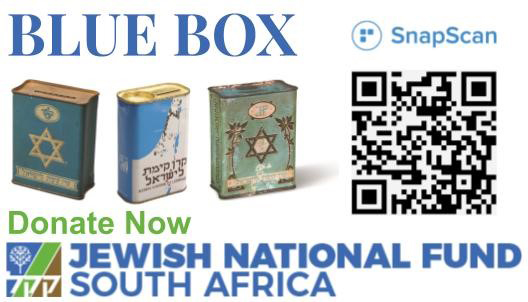Community
JNF Blue Box enters the digital age

When is a Jewish National Fund (JNF) Blue Box not a blue box? Never. Even though the physical box now has a digital donation option, it’s still the age-old Blue Box.
This box has for decades symbolised the JNF and the commitment of Jewish people around the world to rebuild Israel.
And for decades, it has been filled to the brim with pennies, cents, nickels, dimes, lira, and francs – coins of every denomination dropped in, one could almost say, religiously every Friday evening before Shabbat candle lighting.
Now it’s no longer limited to physical coins and a metal box. The new Blue Box with a digital donation option via SnapScan will be launched in time for Channukah to keep the tradition of the Blue Box alive for the next 120 years.
The first real Blue Box was, oddly enough, Theodor Herzl’s hat. At the Fifth Zionist Congress in 1901, he used his hat to solicit donations from delegates as a means of purchasing land to establish a Jewish homeland.
Soon after, a Polish bank clerk proposed that a collection box bearing the words “National Fund” be placed in every Jewish home to raise money for land purchases. Production began in Vienna. The boxes were initially produced in a blue material and thus became known as Blue Boxes.
Over the past 120 years, funds collected via the Blue Box from around the world have assisted the JNF to realise its aim of developing land in Israel: building roads and water reservoirs, establishing parks, and preparing the soil for agriculture and settlement. Beyond fundraising, the Blue Box is also an important educational tool for spreading the Zionist message and renewing the historic bond between the Jewish people and EretzYisrael.
Stories about the Blue Box have become legendary. In the United States around Tu B’Shvat, teams of children brandishing JNF Blue Boxes would travel from Brooklyn to Manhattan on the New York City subway system. They would move from train car to train car with these ubiquitous boxes in hand, soliciting contributions from passengers and stopping only when they sensed or saw the approach of policemen.
In South Africa, members of the JNF would visit Jewish homes every Sunday to collect and then empty Blue Boxes, diligently counting the hundreds or thousands of coins inside them. In addition to being proudly displayed in almost every South African Jewish home, Blue Boxes were also present in schools, shuls, Jewish-owned businesses, medical waiting rooms, even hairdressing salons.
In times past when life wasn’t so frenetic and women could spend afternoons playing rummy and socialising, the money raised and won during the games was often dropped into the Blue Box, adding to the largesse and reputation of that particular hostess.
Today the iconic Blue Box (or pushke) remains the link between the Jewish people and the land, and to many, perhaps even to the majority of the Jewish world, it’s a symbol of Jewish continuity. They can also be quite valuable: a few antique Blue Boxes were auctioned by Sotheby’s recently, realising more than $3 000 (R46 006) each.
However, in the age of credit cards, cryptocurrency, and e-wallets, fundraising via a coin-based Blue Box risks becoming an anachronism.
So, the JNF has relaunched the Blue Box and linked it to the SnapScan mobile-payments app. A QR code will be found on all new Blue Boxes purchased from the JNF. People with old boxes can bring them in to have the QR code imprinted for no extra charge.
It’s modern technology indeed, but inextricably linked to a century-old tradition of keeping Israel alive in every Jewish heart.